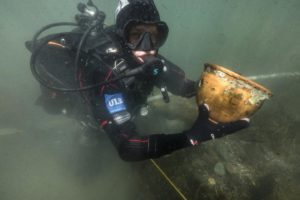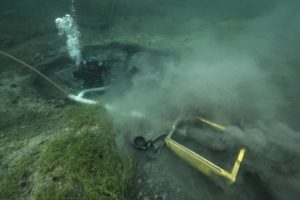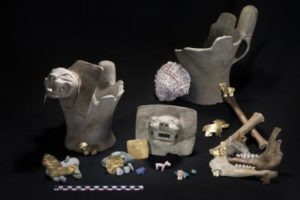PROCEEDINGS OF THE NATIONAL ACADEMY OF SCIENCES—A study* uncovers archaeological evidence that underscores the role of religious rituals, including animal sacrifice, in state formation in the Lake Titicaca basin. Religion is thought to have promoted cooperation between groups and consolidated the ancient Tiwanaku state between 500 and 1100 CE in the Lake Titicaca basin in south-central Andes. However, a dearth of evidence of rituals has hampered understanding of religion’s role in reinforcing a moral code of behavior that supported state formation in the region. In 2013, Christophe Delaere, José Capriles, and Charles Stanish conducted underwater excavations in Khoa Reef in an archipelago on Bolivia’s Island of the Sun in the Titicaca basin, extending previous excavations. The authors surfaced Tiwanaku puma incense burners, metal ornaments, including gold medallions engraved with the Tiwanaku ray-faced deity, and semiprecious stone artifacts, including a turquoise stone pendant, a lapis-lazuli puma figurine, and green glacier moraine stones. Animal bones recovered from the submerged deposits were traced to teals, cormorants, frogs, killifish, and catfish, and, unexpectedly, camelids. Osteometric analysis identified the camelid bones as domesticated llamas, and the completeness of the assemblage suggested at least one infant and three juvenile llamas were likely sacrificed. Radiocarbon dating traced the offerings to 794-964 CE, consistent with expansion of the Tiwanaku state. Religious iconography on the ornaments as well as the sumptuary gold, shell, and lapidary finds signaling ceremonial disposal of wealth hinted at the rituals’ relevance to state formation. Together, the evidence suggests that Khoa, situated at a vantage in the middle of the lake, was a hub for religious rituals officiated by an elite group. Such rituals, marked by worship of the ray-faced deity, animal sacrifice, and display of wealth, may have consolidated power and served as a binding sinew for the Tiwanaku body politic, according to the authors.
_____________________________

A modern underwater offering (Lake Titicaca, Bolivia). Teddy Seguin (photographer)
_____________________________

Underwater excavation unit (Lake Titicaca, Bolivia). Teddy Seguin (photographer)
_____________________________

Typical Tiwanaku-Period offering in the Khoa reef (Lake Titicaca, Bolivia). Teddy Seguin (photographer)
_____________________________
Article Source: PNAS news release
*”Underwater ritual offerings in the Island of the Sun and the formation of the Tiwanaku state,” by Christophe Delaere, José Capriles, and Charles Stanish








